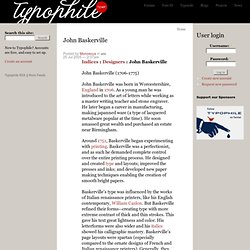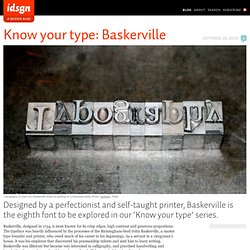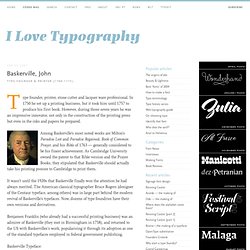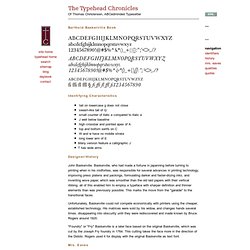

John Baskerville - type-founder and printer, 1706-1775 - Josiah Henry Benton - Google eBookstore. John Baskerville. Indices : Designers : John Baskerville John Baskerville (1706-1775) John Baskerville was born in Worcestershire, England in 1706.

As a young man he was introduced to the art of letters while working as a master writing teacher and stone engraver. He later began a career in manufacturing, making japanned ware (a type of lacquered metalware popular at the time). He soon amassed great wealth and purchased an estate near Birmingham. Around 1751, Baskerville began experimenting with printing. Baskerville's type was influenced by the works of Italian renaissance printers, like his English contemporary, William Caslon. Baskerville's work was widely dismissed during his time by British contemporaries as the work of an amateur. Know your type: Baskerville.
‘Typography’ in 60pt Fry’s Baskerville ready for printing on a Stanhope press (Photo: fizzkitten, Flickr) Designed by a perfectionist and self-taught printer, Baskerville is the eighth font to be explored in our ‘Know your type’ series.

Baskerville, designed in 1754, is most known for its crisp edges, high contrast and generous proportions. The typeface was heavily influenced by the processes of the Birmingham-bred John Baskerville, a master type-founder and printer, who owed much of his career to his beginnings. As a servant in a clergyman’s house, it was his employer that discovered his penmanship talents and sent him to learn writing. The Elements of Typographic Style (9780881792065): Robert Bringhurst. John Baskerville. Type Founder & Printer (1706-1775) Type founder, printer, stone cutter and lacquer ware professional.

In 1750 he set up a printing business, but it took him until 1757 to produce his first book. However, during those seven years he was an impressive innovator, not only in the construction of the printing press but even in the inks and papers he prepared. Among Baskerville’s most noted works are Milton’s Paradise Lost and Paradise Regained, Book of Common Prayer, and his Bible of 1763 — generally considered to be his finest achievement. As Cambridge University owned the patent to that Bible version and the Prayer Books, they stipulated that Baskerville should actually take his printing presses to Cambridge to print them. It wasn’t until the 1920s that Baskerville finally won the attention he had always merited. Baskerville Typeface: It is classified as transitional. Typeface: Baskerville. Berthold Baskerville Book Identifying Characteristics tail on lowercase g does not close swash-like tail of Q small counter of italic e compared to italic a J well below baseline high crossbar and pointed apex of A top and bottom serifs on C W and w have no middle stroke long lower arm of E Many version feature a calligraphic J T has wide arms Designer/History John Baskerville.

Baskerville, who had made a fortune in japanning before turning to printing when in his midforties, was responsible for several advances in printing technology, improving press platens and packings, formulating darker and faster-drying inks, and inventing wove paper, which was smoother than the old laid papers with their vertical ribbing. all of this enabled him to employ a typeface with sharper definition and thinner elements than was previously possible. Unfortunately, Baskerville could not compete economically with printers using the cheaper, established technology. Mrs. Mrs. Say What? Baskerville. The Folio Bible printed by Baskerville in 1763.

The Baskerville typeface is the result of John Baskerville's intent to improve upon the types of William Caslon. He increased the contrast between thick and thin strokes, making the serifs sharper and more tapered, and shifted the axis of rounded letters to a more vertical position. The curved strokes are more circular in shape, and the characters became more regular. These changes created a greater consistency in size and form. Baskerville's typeface was the culmination of a larger series of experiments to improve legibility which also included paper making and ink manufacturing. John Baskerville: type-founder and printer, 1706-1775 - Josiah Henry Benton.
Baskerville Old Face. John Baskerville. Information about the typeface designer John Baskerville and his fonts.

Born in Worcestershire in 1706, he spent the rest of his life in Birmingham. His masterpiece, the Holy Bible of 1763, is regarded by many to be the finest book printed in English. A towering figure in the history of English typography, he broke one tradition and started another. Before Baskerville, the standard English type of the early 18th century was Caslon - a tradition which stretched back to Aldus Manutius of the 15th century. John Baskerville improved existing types, ink and presses and produced a clearer blacker type than any of his contemporaries. He has been called "the greatest printer England ever produced" but was very much disliked by his contemporaries.
"Having been an early admirer of the beauty of Letters, I became intensely desirous of contributing to the perfection of them. " Fonts designed by John Baskerville: About the biographies · Submit a biography.